I am doing IPC with a python subprocess. For now, let's assume I have to use subprocess.Popen to spawn the other process, so I can't use multiprocessing.Pipe for communication. The first thing, that came to my mind is to use their STDIO streams with pickle.load+pickle.dump (don't worry about security right now).
However, I noticed, that the transfer rates are just terrible: order of 750KB/s on my machine! This is slower than communicating via multiprocessing.Pipe by a factor of 95, which uses pickle as well, as far as I understand it. There is no benefit in using cPickle either.
(Update: Note, I realized, this is only the case on python2! On python3 it works fine.)
Why is this so terribly slow? I suspect the reason is somewhere in the way that IO is performed in .dump/.load via python file objects not the C file descriptors. Maybe it has something to do with the GIL?
Is there any way cross-platform way to get the same speed as multiprocessing.Pipe?
I have already found out, that on linux it is possible to use _multiprocessing.Connection (or multiprocessing.connection.Connection on python3) to wrap the STDIO file descriptors of the subprocess and get what I want. However, this is not possible on win32, and I don't even know about Mac.
Benchmark:
from __future__ import print_function
from timeit import default_timer
from subprocess import Popen, PIPE
import pickle
import sys
import os
import numpy
try:
from _multiprocessing import Connection as _Connection
except ImportError:
from multiprocessing.connection import Connection as _Connection
def main(args):
if args:
worker(connect(args[0], sys.stdin, sys.stdout))
else:
benchmark()
def worker(conn):
while True:
try:
amount = conn.recv()
except EOFError:
break
else:
conn.send(numpy.random.random(amount))
conn.close()
def benchmark():
for amount in numpy.arange(11)*10000:
pickle = parent('pickle', amount, 1)
pipe = parent('pipe', amount, 1)
print(pickle[0]/1000, pickle[1], pipe[1])
def parent(channel, amount, repeat):
start = default_timer()
proc = Popen([sys.executable, '-u', __file__, channel],
stdin=PIPE, stdout=PIPE)
conn = connect(channel, proc.stdout, proc.stdin)
for i in range(repeat):
conn.send(amount)
data = conn.recv()
conn.close()
end = default_timer()
return data.nbytes, end - start
class PickleConnection(object):
def __init__(self, recv, send):
self._recv = recv
self._send = send
def recv(self):
return pickle.load(self._recv)
def send(self, data):
pickle.dump(data, self._send)
def close(self):
self._recv.close()
self._send.close()
class PipeConnection(object):
def __init__(self, recv_fd, send_fd):
self._recv = _Connection(recv_fd)
self._send = _Connection(send_fd)
def recv(self):
return self._recv.recv()
def send(self, data):
self._send.send(data)
def close(self):
self._recv.close()
self._send.close()
def connect(channel, recv, send):
recv_fd = os.dup(recv.fileno())
send_fd = os.dup(send.fileno())
recv.close()
send.close()
if channel == 'pipe':
return PipeConnection(recv_fd, send_fd)
elif channel == 'pickle':
return PickleConnection(os.fdopen(recv_fd, 'rb', 0),
os.fdopen(send_fd, 'wb', 0))
else:
raise ValueError("Invalid channel: %s" % channel)
if __name__ == '__main__':
main(sys.argv[1:])
Results:

Many thanks for reading,
Thomas
Update:
Okay, so I profiled this as suggested by @martineau. The following results are obtained in independent invocations for a single run with the fixed value of amount=500000.
In the parent process, the top calls sorted by tottime are:
11916 function calls (11825 primitive calls) in 5.382 seconds
Ordered by: internal time
ncalls tottime percall cumtime percall filename:lineno(function)
35 4.471 0.128 4.471 0.128 {method 'readline' of 'file' objects}
52 0.693 0.013 0.693 0.013 {method 'read' of 'file' objects}
4 0.062 0.016 0.063 0.016 {method 'decode' of 'str' objects}
In the subprocess:
11978 function calls (11855 primitive calls) in 5.298 seconds
Ordered by: internal time
ncalls tottime percall cumtime percall filename:lineno(function)
52 4.476 0.086 4.476 0.086 {method 'write' of 'file' objects}
73 0.552 0.008 0.552 0.008 {repr}
3 0.112 0.037 0.112 0.037 {method 'read' of 'file' objects}
This got me worried, that the usage readline may be the reason for the bad performance.
The following connection uses only pickle.dumps/pickle.loads together with write/read.
class DumpsConnection(object):
def __init__(self, recv, send):
self._recv = recv
self._send = send
def recv(self):
raw_len = self._recvl(4)
content_len = struct.unpack('>I', raw_len)[0]
content = self._recvl(content_len)
return pickle.loads(content)
def send(self, data):
content = pickle.dumps(data)
self._send.write(struct.pack('>I', len(content)))
self._send.write(content)
def _recvl(self, size):
data = b''
while len(data) < size:
packet = self._recv.read(size - len(data))
if not packet:
raise EOFError
data += packet
return data
def close(self):
self._recv.close()
self._send.close()
Indeed, its speed is only 14 times worse than that of multiprocessing.Pipe. (Which is still terrible)
Profiling now, in parent:
11935 function calls (11844 primitive calls) in 1.749 seconds
Ordered by: internal time
ncalls tottime percall cumtime percall filename:lineno(function)
2 1.385 0.692 1.385 0.692 {method 'read' of 'file' objects}
4 0.125 0.031 0.125 0.031 {method 'decode' of 'str' objects}
4 0.056 0.014 0.228 0.057 pickle.py:961(load_string)
in child:
11996 function calls (11873 primitive calls) in 1.627 seconds
Ordered by: internal time
ncalls tottime percall cumtime percall filename:lineno(function)
73 1.099 0.015 1.099 0.015 {repr}
3 0.231 0.077 0.231 0.077 {method 'read' of 'file' objects}
2 0.055 0.028 0.055 0.028 {method 'write' of 'file' objects}
So, I still have no real clue, what to use instead.